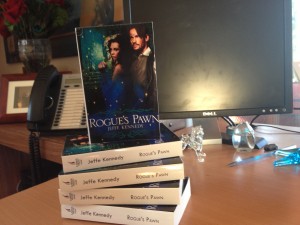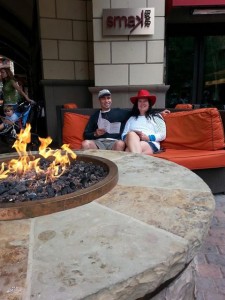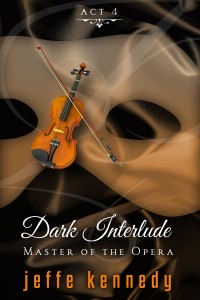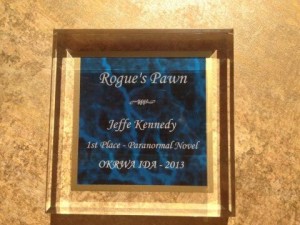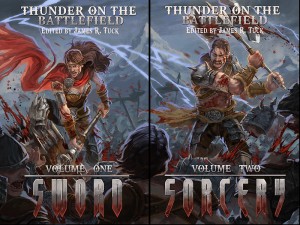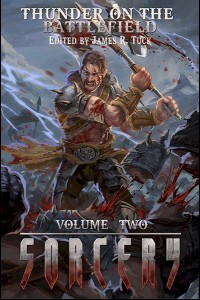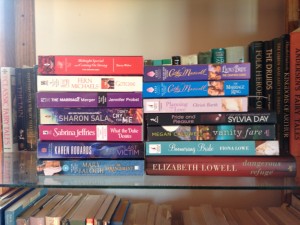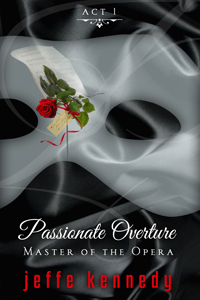
Looky! The covers for my Master of the Opera e-serial are starting to appear! The first two are on my website. I actually have the next two, but those will remain SEKRIT until Bookpushers reveals them on August 15. After that, there will be two more! Very exciting. There will be six episodes in all, released about every two weeks starting December 31. (At least, that’s the current word.) Here’s the blurb for Act I: Passionate Overture.
In the first tantalizing installment of Jeffe Kennedy’s ravishing serial novel Master of the Opera, an innocent young woman is initiated into a sensual world of music, mystery, passion–and one man’s private obsession. . .
Fresh out of college, Christine Davis is thrilled to begin a summer internship at the prestigious Sante Fe Opera House. But on her first day, she discovers that her dream job has a dark side. Beneath the theater, a sprawling maze of passageways are rumored to be haunted. Ghostly music echoes through the halls at night. And Christy’s predecessor has mysteriously disappeared. Luckily, Christy finds a friend and admirer in Roman Sanclaro, the theater’s wealthy and handsome patron. He convinces her there’s nothing to fear–until she hears the phantom’s voice for herself. Echoing in the labrynths. Singing of a lost love. Whispering her name: Christine.
At first, Christy thinks she’s hearing things. But when a tall masked man steps out of the shadows–and into her arms–she knows he’s not a phantom of her imagination. He is the master of her desire. . .
Didn’t they make it sound awesome? Even *I* want to read it…
So, I mentioned on Twitter that I was the subject of a priest’s sermon – and I was the GOOD example. Now, I’m trying not to be hurt that none of you believed me and I *did* promise to tell the story today, so….
Back in July, as some of you may or may not know, David and I made the journey up to northern Wyoming to bury his father. We’d been expecting it as his dad, GF, had moved into hospice a week or two before he died. Still, it was wrenching. GF was the head of a large and happy family, a courageous and warm-hearted person and we’ll miss him greatly. For us this was a three-day event, because Buffalo, Wyoming is one of those “you can’t get there from here” places. We spent Wednesday driving an hour from Santa Fe to Albuquerque, flying to Denver, taking a 19-seat prop airplane to Casper, Wyoming, renting a car and driving another two hours to Buffalo. Then we turned around and did it in reverse on Friday.
The rosary was Wednesday night and the service Thursday morning. If any of you are Catholics – or have the misfortune to be connected to Catholics – then you’ll know these were not brief services. The full Catholic Mass funeral and graveside service on Thursday took 3 1/2 hours. After that we returned to the church to eat, then hung out at David’s parents’ house for the rest of the day and evening.
It ended up being good, because it slowed us down. There was nothing to be done, but hang out, eat food, drink wine (this is the up-side of the Catholics!) and talk.
Driving back down to Casper on Friday morning, we were emotionally exhausted. We talked about the family and related conversations we’d had without each other. David was driving and I glanced down, noticing something between my seat and the center console. I dug it out and discovered it was an American passport. The owner hadn’t filled out his contact information (Bad!), but I had his name, birthday and general location.
So I searched on my smart phone and found a guy his age living in the right area. I called the number and got an anonymous voice mail, so I left a message. I really hoped he wasn’t traveling somewhere and stuck without his passport. We debated what to do then. David suggested leaving it with TSA at Casper airport. I thought TSA would likely destroy it or it would disappear into the vast depths that suck up all the stuff TSA confiscates. When we returned the rental car, I asked the very young workers at the counter if anyone had called looking for the passport. They said no. I didn’t really want to leave it with them either, because, well… they seemed sweet but not terribly conscientious.
I took it with me.
During our layover in the Denver airport, my cell phone rang and it was him! Turns out this guy is a priest, lives in Buffalo, New York, and had missed the passport but had no idea how to go about dealing with it. He’d flown out to Wyoming the week before to help another priest struggling with a problem in his community.
I felt kind of emotional about it. The time we’d spent doing the rosary, mass and funeral was easily the most time I’d been in a church in years, maybe decades. I’m not a religious person – this likely comes as no shock to you all – but I did major in religious studies in college. More, I associate the church with my family. I often joke that I’m Catholic the same way that I’m Irish – it’s in the genes, whether I observe anything or not. GF died on July 4. David and I were in Denver at the time, helping my mom and Stepdad Dave clear out the house I grew up in. My stepfather Leo, a former Catholic priest, had married my mother a year after we moved in and died there 35 years later. His brother, my uncle who is still Catholic priest, was heavy on my mind. He’s living in an assisted living/retirement community and had really dropped contact with us after Leo passed away. While I was in Denver, I called the place, as my uncle canceled his cell phone, and got his mailing address. I tried to call him on his room phone, but got his voice mail.
The Monday after we got home, I took the passport to the post office and mailed it to Father Sam. With it I included a note where I talked about some of these same things. I wasn’t sure what it all meant, but it felt like it did mean something.
This week, a big box arrived for me. Turns out Father Sam of Buffalo, New York, also runs a bakery! This story can’t get any better. He sent me pita bread, amazingly delicious olive oil, salsa and these thin nacho chips that are out of this world. He also enclosed a note:
Dear Jeffe Kennedy,
Thank you! It is always good to be at the other end of a nice action. I have already used what you did as an example in my sermon this past Sunday. It often is a “pain in the neck” to go out of our way esp. when we are about hard stuff in our own lives.
You have made a difference and I preach a lot that God calls us to make a difference not save the world. He will do that!
God Bless you and your family,
Father A Sam
I want you all to know that I wept a little bit, even transcribing that. I’m not sure I can explain why. Maybe because I struggle sometimes with feeling like I’m not always the best person I can be. I dwell sometimes on friendships and connections I’ve lost, why some seem to end for no reason at all – except that I suspect it’s my fault, somehow. Maybe part of the take-home message is that making a difference for someone else doesn’t have to be a grand action. Even the little things count.
At any rate, I didn’t mean to make this a sad story – or such a long one! You all have a lovely weekend. Carien and Amy, you won books from Tuesday’s post, so let me know which ones you want!

